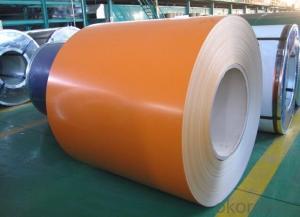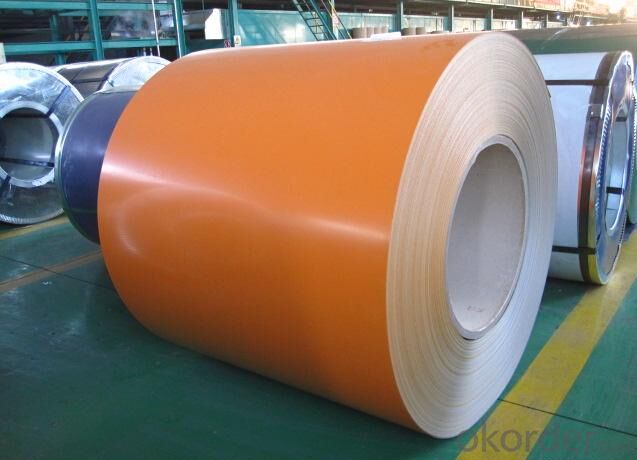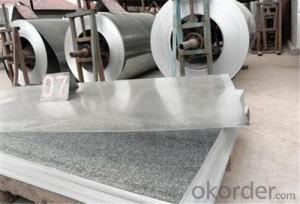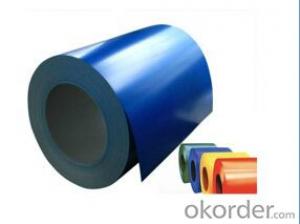Pre-painted Galvanized/Aluzinc Steel Sheet Coil with Prime Quality and Lowest Price in Orange
- Loading Port:
- Shanghai
- Payment Terms:
- TT OR LC
- Min Order Qty:
- 100 m.t.
- Supply Capability:
- 10000 m.t./month
OKorder Service Pledge
OKorder Financial Service
You Might Also Like
1.Pre-Painted Galvanized/Aluzinc Steel Coil Description:
Pre-painted Galvanized/Aluzinc Steel Coil with GI or Aluzinc as base metal,after pretreatment,
2.Main Features of the Pre-Painted Galvanized/Aluzinc Steel Coil
• High strength
• Good capable of decoration
3.Detail Images of Pre-Painted Galvanized Steel Coil
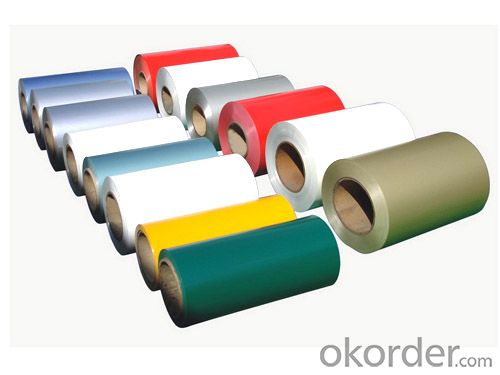
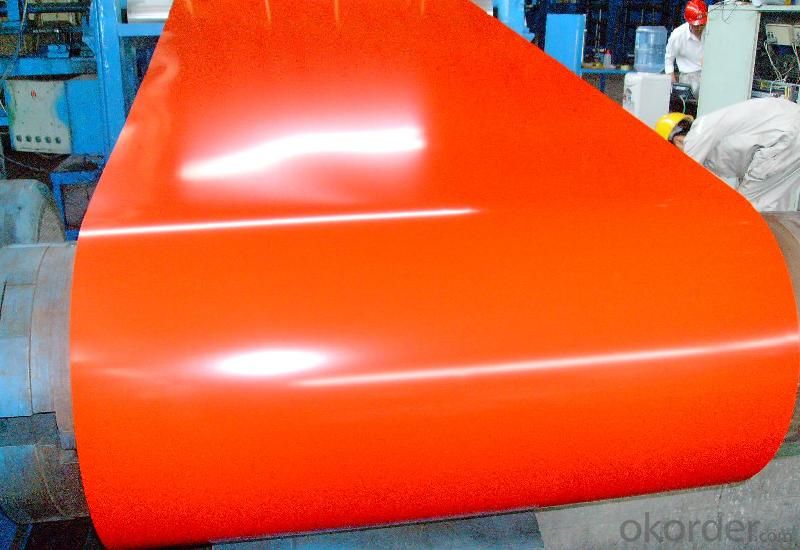
4.Quick Details of the Pre-Painted Galvanized/Aluzinc Steel Coil
Standard | ASTM ,EN,JIS | Grade: | CS,DX51D+Z,CGCC | Thickness | 0.16mm-1.5mm |
Place of Origin | China(Mainland) | Brand Name | Type | Steel Coil | |
Technique | Galvanized/Aluzinc | Surface | Coated | Application | Roof panel |
Width | 900mm-1250mm | Length | Coils | Zinc Coating | 30g/m2-275g/m2 |
5.Specification of PPGI / GI Steel Sheet/Coil
1) AVAILABLE DESIGNATION OF PPGI/PPGL Prepainted Galvanized/Galvalume Steel Coils
Quality | Q/BQB 440-2003 | JIS G3312-1994 | EN 10326-2004 | ASTM A653-02a |
EN 10327-2004 | (BASE PLATE) | |||
(BASE PLATE) | ||||
Commercial Steel | TDC51D | CGCC | DX51D+Z/AZ | CS Type A/B/C |
Forming Steel | (TSt01,TSt02,TSt03) | CGCD1 | FS Type A, Type B | |
Drawing | TDC52D /TDC53D | - | DX52D+Z/AZ | DDS TYPE A/C |
Steel | DX53D+Z/AZ | |||
Structural | TS280GD(TStE28) | CGC400 | S280D+Z/AZ | SS275 |
3) APPLICATION OF PPGI/PPGL (Prepainted Galvanized/GalvalumeSteel Coils)
Construction | Outside | Workshop, agricultural warehouse, residential precast unit, corrugated roof, roller shutter door, rainwater drainage pipe, retailer booth |
Inside | Door, doorcase, light steel roof structure, folding screen, elevator, stairway, vent gutter | |
Electrical appliance | Refrigerator, washer, switch cabinet, instrument cabinet, air conditioning, micro-wave oven, bread maker | |
Furniture | Central heating slice, lampshade, chifforobe, desk, bed, locker, bookshelf | |
Carrying trade | Exterior decoration of auto and train, clapboard, container, isolation lairage, isolation board | |
Others | Writing panel, garbage can, billboard, timekeeper, typewriter, instrument panel, weight sensor, photographic equipment | |
6.FAQ
1. What’s the application of this product?
Roof, roof structure, surface sheet of balcony, frame of window, etc.
- Q: I want to know because I'm going to Hershey Park on Wednesday and Steel Force looks about the same size, so, I wanted to know. It's not that Steel Force is too big for me.
- steel force breaks the 200ft mark and is a steel out and back roller coaster. Tidal force is a water ride that is about 100 ft tall. If you can do Steel Force then you should be able to handle anything at Hersheypark. the on;y ride they have bigger is the Kissing Tower
- Q: How are steel coils used in the manufacturing of telecommunications equipment?
- Steel coils are used in the manufacturing of telecommunications equipment for various purposes. They are often used to create the framework and structure of the equipment, providing stability and support. Additionally, steel coils can be used for manufacturing components such as brackets, mounts, and enclosures, ensuring durability and protection for the sensitive electronic components inside the equipment.
- Q: What are the different types of steel coil welding methods?
- There are three main types of steel coil welding methods: continuous welding, spot welding, and seam welding. Continuous welding involves joining the edges of steel coils continuously, creating a seamless weld. Spot welding involves applying a series of localized welds at regular intervals along the coil edges. Seam welding is a combination of continuous and spot welding, where a continuous weld is created by intermittent spot welds.
- Q: Ok, lately I've been taking to making things out of stainless steel chain mallie rings. The problem is that when i make a bracelet or something, the area around the fastener always looks pretty bad. I'm thinking to have a friend who also does chain mallie finish the weave all the way around. This would make it look good but make it impossible to remove.Are there any long term problems with stainless steel on skin? I know some metals will change the color of the skin or make the skin absorb some of the metal. Is this something to worry about with stainless steel?
- Stainless steel contains both nickel and chromium. These two alloys are responsible for most of contact dermatitis in people. Some of my co-workers making steel had such bad reactions to chromium that they had to quit their jobs. Their skin was always inflamed. People don't react to finished stainless steel the same way because the alloys are bonded tightly in the heat treating process. But if you are grinding it and getting the dust on your skin, you could get a contact dermatitis if you are sensitive. I don't think it would absorb into your blood stream or do any long term damage to your skin. If you do get a reaction, you would have to cease your exposure or in a worse case scenario risk getting a body wide reaction like my coworkers. I would not worry about any exposure making rings out of stainless steel. After all, stainless steel is used in sugical implants and most people are fine.
- Q: How does coil slitting work?
- Coil slitting is a process used to cut large coils of material, such as metal or plastic, into narrower strips. It involves feeding the coil through a set of rotating circular blades that make longitudinal cuts along the length of the coil. The blades are set at predetermined widths to achieve the desired strip thickness. The process is usually automated and ensures efficient and precise cutting, resulting in multiple narrower coils that can be used for various industrial applications.
- Q: How are steel coils used in the manufacturing of automotive accessories?
- Steel coils are commonly used in the manufacturing of automotive accessories due to their strength, durability, and versatility. These coils serve as the primary raw material for various components and parts used in the automotive industry. One of the most common uses of steel coils in automotive accessory manufacturing is for the production of body panels and frames. These coils are formed and shaped into the desired size and design, and then undergo various processes such as cutting, stamping, and welding to create the body panels and frames of vehicles. The high strength of steel coils ensures that the body panels and frames are sturdy enough to withstand the rigors of daily use and provide the necessary structural integrity to the vehicle. Additionally, steel coils are also used in the production of automotive suspension systems. Coil springs, which are integral components of the suspension system, are typically made from steel coils due to their ability to absorb and distribute the weight and impact of the vehicle. These coil springs contribute to a smooth and comfortable ride by providing the necessary support and shock absorption. Furthermore, steel coils are used in the manufacturing of automotive accessories such as exhaust systems, brackets, and brackets for various components. The coils are formed and shaped into the required design and then undergo processes like cutting, bending, and welding to create these accessories. The strength and durability of steel make these accessories capable of withstanding high temperatures, vibrations, and other harsh operating conditions. In summary, steel coils play a crucial role in the manufacturing of automotive accessories by providing the necessary strength, durability, and versatility required for various components and parts. From body panels to suspension systems and accessories, steel coils contribute to the overall quality, performance, and safety of automotive accessories.
- Q: How are steel coils used in the production of electrical transmission towers?
- Steel coils are used in the production of electrical transmission towers as they are shaped and welded to create the structural framework of the towers. The coils are unrolled, cut, and formed into the required shape, providing strength and stability to support power lines and equipment.
- Q: what is the history of steel and how did they start making it, i need a link or an answer that is five paragraphs long. plus i need examples of subtitles about the history of steel. i am doing this for a science project and hope that someone can help me out.thanks
- There's wide history of steel, you can read different tutorials online to know more about it. Check wiki for detailed information.
- Q: What are the different types of steel coil finishes for aesthetics?
- There are several different types of steel coil finishes that are used for aesthetics, each offering a unique appearance and texture to the steel surface. Some of the most common types of finishes include: 1. Matte finish: This is a low-gloss finish that provides a smooth, non-reflective surface. It offers a clean and modern look to the steel coil, making it suitable for various applications in architectural and interior designs. 2. Brushed finish: Also known as satin finish, this type of finish is achieved by brushing the steel surface with a fine abrasive material. It creates a subtle, directional grain pattern on the surface, giving it a textured appearance. Brushed finishes are often used in kitchen appliances, decorative elements, and furniture. 3. Mirror finish: As the name suggests, this finish creates a highly reflective surface that resembles a mirror. It is achieved by polishing the steel surface to a high shine using abrasive materials. Mirror finishes are commonly used in architectural applications, such as decorative panels, elevator doors, and signage. 4. Patterned finish: This type of finish involves embossing or etching a pattern onto the steel surface. It can range from simple geometric designs to intricate textures, offering a unique and visually appealing look. Patterned finishes are widely used in interior design, automotive trims, and decorative panels. 5. Textured finish: Textured finishes are created by applying a texture to the steel surface, such as a stucco or diamond pattern. This adds depth and visual interest to the coil, making it suitable for various applications, including wall cladding, roofing, and garage doors. 6. Colored finish: In addition to different surface textures, steel coils can also be finished with various colors. This is achieved through the application of a coating or paint system, which not only enhances the aesthetic appeal but also provides protection against corrosion. Colored finishes are commonly used in architectural applications, such as building facades, window frames, and decorative elements. Overall, the choice of steel coil finish depends on the desired aesthetic outcome, as well as the specific requirements and intended application of the steel product.
- Q: How are steel coils used in the production of consumer goods?
- Steel coils are used in the production of consumer goods as raw materials for various manufacturing processes. They are often shaped, cut, or formed into different components and parts that go into products such as appliances, automobiles, furniture, and construction materials. Steel coils provide strength, durability, and versatility, making them essential in creating high-quality consumer goods.
Send your message to us
Pre-painted Galvanized/Aluzinc Steel Sheet Coil with Prime Quality and Lowest Price in Orange
- Loading Port:
- Shanghai
- Payment Terms:
- TT OR LC
- Min Order Qty:
- 100 m.t.
- Supply Capability:
- 10000 m.t./month
OKorder Service Pledge
OKorder Financial Service
Similar products
Hot products
Hot Searches
Related keywords
